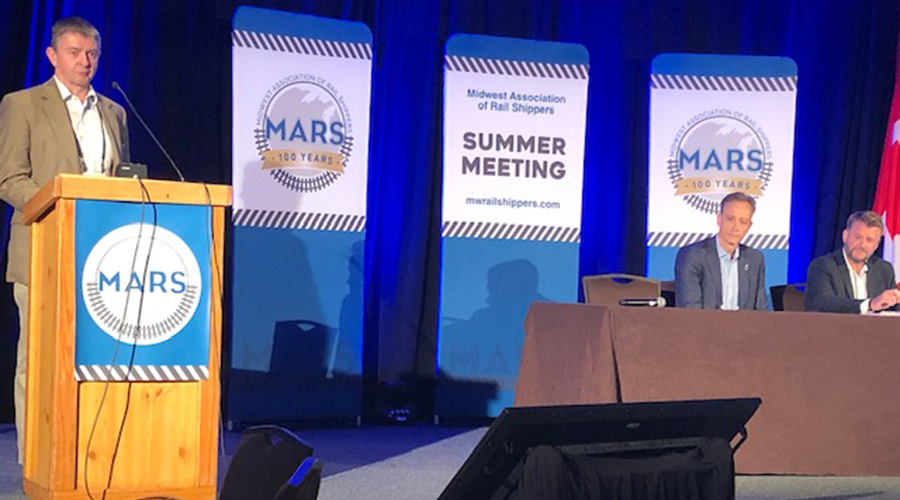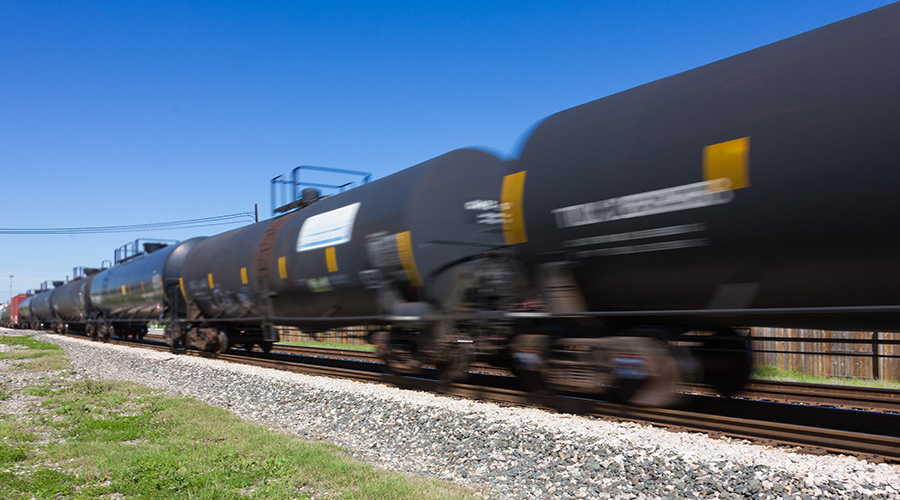Speakers touched on hot topics at MARS summer meeting
7/15/2024
By Jeff Stagl, Managing Editor
The Midwest Association of Rail Shippers (MARS) turned 100 this year. Its predecessor organization started holding meetings in 1924 to help solve transportation problems experienced by freight-rail shippers at the time.
So, it’s fitting that MARS set a summer meeting attendance record during its centenary year. The meeting — which was held July 8-9 in Lake Geneva, Wisconsin — drew an all-time-high 460 attendees.
Headquartered in Chicago, MARS draws members from Illinois, Indiana, Iowa, Michigan, Minnesota, Missouri, Nebraska, North Dakota, Ohio, South Dakota, Wisconsin, and the provinces of Manitoba and Saskatchewan. The association serves as an open forum for rail shippers to resolve transportation and car supply problems, and provides programs designed to educate and inform members about railroad operating practices, new transportation innovations and legislative matters.
The summer meeting included eight presentations on July 9 at the Geneva Lakes Resort that involved 13 speakers from the Class I, short line, rail shipper, regulatory and rail supply sectors. The topics covered — some of which could be characterized as hot-button issues — ranged from economic challenges to growth strategies to emerging rail industry technologies to regulatory and legislative developments to rail shipper concerns.
Following are comments made by some of the speakers.
Michael Miller, CEO-North America for Genesee & Wyoming Inc., during a fireside chat with American Short Line and Regional Railroad Association President Chuck Baker
For Miller, service metrics such as car velocity or train performance don’t mean much to customers. Since each customer has unique service requirements, successful performance boils down to providing the service a customer’s business truly requires, he said.
To be an optimal service provider and to grow, two important points need to be considered: change is inevitable and interconnectedness is vital.
Railroads can’t continue to do business as usual if they expect to grow market share, Miller believes.
“You have to have the courage to change and yet maintain the [business] principles that are timeless,” he said.
Railroads also need to stop operating in their own silos.
“Our ecosystem performs better when we work together. The industry is highly interconnected and highly interdependent,” said Miller. “It’s about how we can create value by working together.”
One prime example of that is the Meridian & Bigbee Railroad LLC joint venture deal. Canadian Pacific Kansas City and CSX plan to acquire G&W’s 168-mile Meridian & Bigbee Railroad to create a shortcut interchange route linking the U.S Southeast and Mexico via Myrtlewood, Alabama. G&W would continue to provide local service in the region.
“We get to serve the local customers and then get out of the way on the mainline. Let the Class Is do what they do best,” said Miller. “We are open to discussions about deals like this. There are other corridors we are looking at.”
 During an engaging presentation, BNSF VP Jon Gabriel cited a lot of interesting data examples and discussed how the Class I is trying to better manage and process data. Jeff Stagl
During an engaging presentation, BNSF VP Jon Gabriel cited a lot of interesting data examples and discussed how the Class I is trying to better manage and process data. Jeff StaglJon Gabriel, vice president of network strategy, design and innovation for BNSF Railway Co. (he will become group VP of consumer products on Sept. 1)
During an engaging presentation, Gabriel cited a lot of data and talked about data processing. He began by saying 120 zettabytes of data were generated in the world in 2023, and that figure is expected to double in two years.
One zettabyte is equal to one trillion gigabytes, and one gigabyte is one billion bytes of data.
BNSF alone processes 30 million databytes each day. While data is what energizes business, what a company does with it to make a customer’s experience better is what matters, said Gabriel.
To that end, BNSF has created more than 20 data scientist and research scientist positions to better process data and leverage technology for customers, including artificial intelligence (AI), he said. Currently, AI is incorporated into operations in more than a dozen key functions.
Another data example Gabriel shared involves Starbucks. The national coffee chain offers 383 billion possible combinations of drinks given customers’ unique requests and demands.
“It’s about customization and complexity, and that has a lot to do with railroading,” said Gabriel.
If BNSF is managing 10 cars on four tracks in a yard — and yards typically have many more tracks and yards than that — there are 5.2 million ways to switch cars, he said.
“We are moving to automated, optimally planned switching operations. We want to make them more consistent,” said Gabriel.
BNSF also is trying to provide shippers more accurate estimated times of arrival (ETAs), in part with the use of AI, and deciding whether to join the RailPulse coalition. Recently joined by CSX, RailPulse is a coalition of rail-car owners that are developing and accelerating the use of GPS and other telematics technologies on cars.
“The only thing worse than no ETA data is bad ETA data,” says Gabriel, adding that BNSF is monitoring RailPulse’s progress with testing and launching a telematics solution.
Karen Hedlund, vice chairman of the Surface Transportation Board
A historic moment at the board occurred on May 11 when STB Member Robert Primus became chairman. He now is the first African American to lead the agency since predecessor organization the Interstate Commerce Commission was created in 1887, Hedlund said.
Primus succeeded Martin Oberman, who retired from the STB in early May. It remains to be seen what the leadership change will mean at the board in the near term, Hedlund said.
“I will leave it up to [Primus] to speak to his agenda,” she said.
In the meantime, the STB — which should have five members — will remain at four members for a while, given the upcoming presidential election, current political climate and other factors, Hedlund said.
It’s been a busy couple of years for STB members, who have reviewed and dealt with such complicated matters as the Canadian Pacific-Kansas City Southern merger, Class I service issues, Amtrak and Class I disagreements regarding Gulf Coast passenger rail and a rule on reciprocal switching. And the board figures to remain very active.
A concern that needs addressing is the lack of significant traffic growth at railroads, Hedlund said. Only about 30% of goods move by rail in the United States.
“Coal traffic has declined faster than first thought. And merchandise traffic has shrunk,” Hedlund said.
The Supreme Court’s recent ruling on the Chevron case warrants attention, too. The court sharply reduced the power of federal agencies to interpret the laws they administer and determined that courts should rely on their own interpretation of ambiguous laws.
“This provides another argument to make to challenge our decisions,” said Hedlund. “But we are not in a panic about it. The ruling affects other [federal] agencies more.”
In addition, the STB is monitoring the so-called “CARB” rule in California. Last year, the California Air Resources Board finalized a rule that would require freight railroads operating in the state to adopt zero-emission locomotives for industrial use by 2030 and for normal hauling by 2035. The rule would need to be approved by the U.S. Environmental Protection Agency.
“Short lines say the rule is unfeasible,” said Hedlund. “And BNSF has said they will have to changeout locomotives at the state border if it’s enacted.”
 CPKC’s hydrogen locomotive program has the potential to significantly reduce greenhouse-gas emissions and support the company’s climate change commitments, said Matthew Findlay (at far left), who has certain program responsibilities. Jeff Stagl
CPKC’s hydrogen locomotive program has the potential to significantly reduce greenhouse-gas emissions and support the company’s climate change commitments, said Matthew Findlay (at far left), who has certain program responsibilities. Jeff StaglMatthew Findlay, director of mechanical systems for Canadian Pacific Kansas City
During an “innovation panel” presentation with three other speakers, Findlay provided an update on CPKC’s ongoing hydrogen locomotive program. The Class I is trying to develop North America’s first line-haul hydrogen-powered freight locomotive.
Through the program, the railroad is converting three different types of diesel-electric locomotives into zero-emission hydrogen locomotives using fuel cells and batteries to power the electric traction motors.
The program has the potential to significantly reduce greenhouse-gas emissions from locomotive operations, support the company’s climate change commitments and contribute to freight railroading’s transition to a low-carbon future, said Findlay, who also serves as director of hydrogen systems and retains responsibilities for the program.
CPKC has integrated the batteries, fuel cells, and storage areas — which are all modular components — into pre-assemblies called “skids,” he said.
“This process enables a rapid conversion through integration into the existing locomotive modernization process,” said Findlay.
The railroad continues to test four hydrogen locomotives, including a direct current (DC) unit in Alberta. So far, the unit has traveled more than 2,200 miles moving over 1,300 cars during 20 mainline tests. Weekly tests are performed in trains carrying over 20,000 tons at speeds up to 50 mph.
CPKC has found the operating performance of both the original and converted locomotives is identical, Findlay said.
“So far, there have been no in-service failures,” he said of the hydrogen locomotives undergoing tests.
In addition, the Class I has determined that fueling with hydrogen enables flexibility to quickly fuel locomotives directly or from fixed points, providing a significant advantage over battery-only locomotives.
CPKC currently is in the process of commissioning an alternating current hydrogen locomotive, developing other low-horsepower units and continuing tests with the four units.
 “Railroads don’t do things the same way each week,” said Conrad Victor, who heads rail logistics for steel shipper Cleveland-Cliffs Inc. Midwest Association of Rail Shippers
“Railroads don’t do things the same way each week,” said Conrad Victor, who heads rail logistics for steel shipper Cleveland-Cliffs Inc. Midwest Association of Rail ShippersConrad Victor, director of rail logistics for steel shipper Cleveland-Cliffs Inc.
Victor first described his company, which is North America's largest flat-rolled steel producer and supplier of iron ore pellets for various industries, mainly automotive. The company ships tens of millions of tons by rail each quarter, he stressed.
Victor then described what he characterized as the barriers to shipping by rail. The first is railroads’ network rigidity.
“Trucks are incredibly flexible. With rail, you have to order cars a week out,” said Victor. “Railroads don’t do things the same way each week.”
Then there are shippers’ and receivers’ perceptions about rail. Many of those are negative, Victor said.
“We need it to be a partnership,” he said.
Demurrage costs are another barrier to rail. Those costs went up in 2017 and 2018 and didn’t come back down, said Victor.
“Shippers and receivers can’t always tailor their schedules to fit railroads,” he said.
And other cost variables are barriers, as well, such as transit time, accessorial charges, freight rates and infrastructure requirements, Conrad explained.
“Trucks rates are down by double digits the last two years,” he said. “We are asking railroads for more flexibility in days of service.”
Victor closed by stating it’s more beneficial for Cleveland-Cliffs to be honest about its experiences with rail service.
“I don’t sugarcoat it,” he said.


